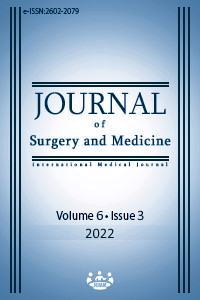Color kinesis-dobutamine stress echocardiography pinpoints coronary artery disease
Keywords:
Color kinesis, Coronary artery disease, Stress echocardiographyAbstract
Background/Aim: Dobutamine stress echocardiography (DSE) can identify significant coronary artery disease (CAD) and where it is localized. However, determining endocardial borders with poor echocardiographic views may create unsatisfactory results. Color kinesis (CK) shows endocardial movement with color, and allows easier and more objective evaluation of ventricular wall motion. In this study, our aim was to evaluate the role of CK in determining CAD localization during DSE. Methods: The study group consists of patients whose CAD diagnosis was confirmed with coronary angiography (CA). Patients with atrial fibrillation (A-Fib), left bundle branch block, poor echocardiography image quality, left ventricular (LV) ejection fraction < 40%, and non-ischemic LV wall motion abnormality were excluded. CK-DSE and dobutamine stress-induced myocardial perfusion scintigraphy (MPS) was done in all patients and compared to CA. Results: A total of twenty patients [16 males (80%) and 4 females (20%)] were included in the study. CK-DSE results were consistent with CA in determining CAD localization (kappa 0.66). Vessel-based kappa values for LAD, RCA, and Cx were 0.81, 0.70 and 0.61, respectively. Consistency between MPS and CK-DSE was evaluated by the area under curves (AUC) within a ROC curve analysis (p > 0.05, 95% CI). Conclusion: Our study showed that CK allows for rapid, objective, and automatic evaluation of segmental wall motion. In addition, CK-DSE is consistent with CA results.
Downloads
References
Mann Douglas L, Zipes DP, Libby P, Bonow RO, Braunwald E. Braunwald's Heart Disease: A Textbook of Cardiovascular Medicine. Tenth edition. Philadelphia, PA: Elsevier/Saunders, 2015. pp. 1050-75.
Onat A. Erişkinlerimizde kalp hastalıkları prevalans, yeni koroner olaylar ve kalpten ölüm sıklığı. Türk erişkinlerinde kalp sağlığının dünü ve bugünü. İstanbul. Türk Kardiyoloji Derneği Arşivi.1996:15-27.
Mann Douglas L, Zipes, DP, Libby P, Bonow RO, Braunwald E. Braunwald's Heart Disease: A Textbook of Cardiovascular Medicine. Tenth edition. Philadelphia, PA: Elsevier/Saunders, 2015. pp. 1189-1235.
Perlof JK, Child JS. Practical clinical application of echocardiography in coronary heart disease. Echocardiography. 1986. pp. 440-51.
Gurunathan S, Senior R. Stress Echocardiography in Stable Coronary Artery Disease. Curr Cardiol Rep. 2017;19:121.
Płońska-Gościniak E, Gackowski A, Kukulski T, Kasprzak JD, Szyszka A, Braksator W, et al. Stress echocardiography. Part I: Stress echocardiography in coronary heart disease. J Ultrason. 2019;19:45-8.
Al-Lamee RK, Shun-Shin MJ, Howard JP, Nowbar AN, Rajkumar C, Thompson D, et al. Dobutamine Stress Echocardiography Ischemia as a Predictor of the Placebo-Controlled Efficacy of Percutaneous Coronary Intervention in Stable Coronary Artery Disease: The Stress Echocardiography-Stratified Analysis of ORBITA. Circulation. 2019;140:1971-80.
Kossaify A, Bassil E, Kossaify M. Stress Echocardiography: Concept and Criteria, Structure and Steps, Obstacles and Outcomes, Focused Update and Review. Cardiol Res. 2020;11:89-96.
Pettemerides V, Turner T, Steele C, Macnab A. Does stress echocardiography still have a role in the rapid access chest pain clinic post NICE CG95? Echo Res Pract. 2019;6:17-23.
Lang RM, Vignon P, Weinert L, Bednarz J, Korcarz C, Sandelski J, et al. Echocardiographic quantification of regional left ventricular wall motion with color kinesis. Circulation. 1996 May 15;93(10):1877-85.
Ishii K, Miwa K, Sakurai T, Kataoka K, Imai M, Kintaka A, et al. Detection of postischemic regional left ventricular delayed outward wall motion or diastolic stunning after exercise-induced ischemia in patients with stable effort angina by using color kinesis. J Am Soc Echocardiogr. 2008;21:309-14.
Mann, Douglas L, Zipes, D. P., Libby, P., Bonow, R. O., & Braunwald, E. Braunwald's Heart Disease: A Textbook of Cardiovascular Medicine. Tenth edition. Philadelphia, PA: Elsevier/Saunders, 2015. pp. 1188-89, 110-111.
Broderick TM, Bourdillon PD, Ryan T, Feigenbaum H, Dillon JC, Armstrong WF. Comparison of regional and global left ventricular function by serial echocardiograms after reperfusion in acute myocardial infarction. J Am Soc Echocardiogr. 1989;2:315-23.
Segar DS, Brown SE, Sawada SG, Ryan T, Feigenbaum H. Dobutamine stress echocardiography: correlation with coronary lesion severity as determined by quantitative angiography. J Am Coll Cardiol. 1992;19:1197-202.
Binak K, İlerigelen B, Sırmacı N, Onsel C. Teknik Kardiyoloji. İstanbul: Form Matbaası;2001.pp.260-81.
DeLong ER, DeLong DM, Clarke-Pearson DL. Comparing the areas under two or more correlated receiver operating characteristic curves: a nonparametric approach. Biometrics. 1988;44:837-45.
Mor-Avi V, Vignon P, Koch R, Weinert L, Garcia MJ, Spencer KT, et al. Segmental analysis of color kinesis images: new method for quantification of the magnitude and timing of endocardial motion during left ventricular systole and diastole. Circulation. 1997;95:2082-97.
Geleijnse ML, Fioretti PM, Roelandt JR. Methodology, feasibility, safety and diagnostic accuracy of dobutamine stress echocardiography. J Am Coll Cardiol. 1997;30:595-606.
Chandraratna PA, Kuznetsov VA, Mohar DS, Sidarous PF, Scheutz J, Krinochkin DV, et al. Comparison of squatting stress echocardiography and dobutamine stress echocardiography for the diagnosis of coronary artery disease. Echocardiography. 2012;29:695-9.
Elhendy A, Geleijnse ML, Roelandt JR, van Domburg RT, Ten Cate FJ, Nierop PR, et al. Comparison of dobutamine stress echocardiography and 99m-technetium sestamibi SPECT myocardial perfusion scintigraphy for predicting extent of coronary artery disease in patients with healed myocardial infarction. Am J Cardiol. 1997;79:7-12.
Downloads
- 374 451
Published
Issue
Section
How to Cite
License
Copyright (c) 2022 Zeki Doğan, Gökhan Bektaşoğlu
This work is licensed under a Creative Commons Attribution-NonCommercial-NoDerivatives 4.0 International License.
















